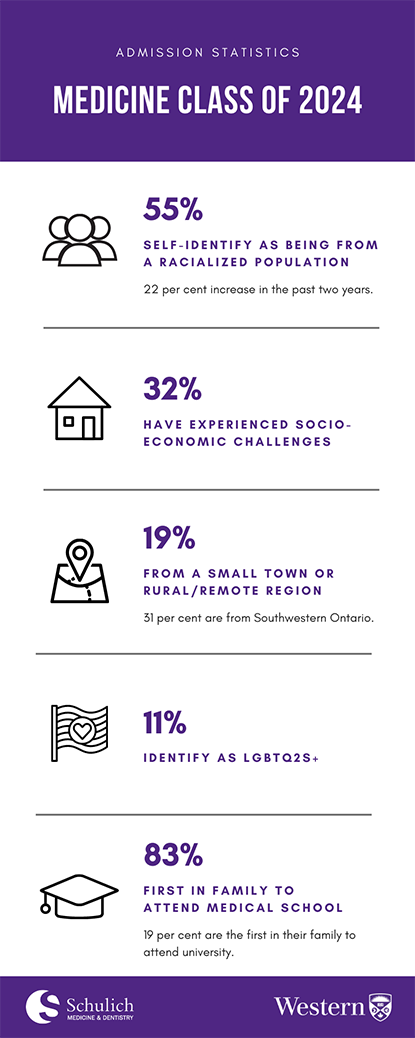Feature: Incoming medical school class represents increased diversity
This year’s incoming medical school class at Schulich Medicine & Dentistry will include a cohort of students from diverse backgrounds, with diverse perspectives that is more representative of communities across Canada.
Significant changes to the medical school admissions process during the past two years have focused on mitigating barriers for underrepresented populations within medicine, such as those who self-identify as racialized, those from low socioeconomic backgrounds and those from rural or remote areas. The admission process also puts more focus on considering both academic and non-academic traits in order to get a more holistic view of applicants’ experiences and values. New for 2019/2020 application cycle was the introduction of the ACCESS pathway. Recognizing that traditional admissions processes may not be equitable to some demographics, this pathway provides MCAT score flexibility for applicants who have had financial, medical or sociocultural challenges. Five per cent of this year’s class applied through this pathway.
New for 2019/2020 application cycle was the introduction of the ACCESS pathway. Recognizing that traditional admissions processes may not be equitable to some demographics, this pathway provides MCAT score flexibility for applicants who have had financial, medical or sociocultural challenges. Five per cent of this year’s class applied through this pathway.
“We were looking for ways to enhance diversity through our admissions process, and a big part of that is understanding what we can do to mitigate barriers for groups that have been underrepresented in medicine in the past,” said Dr. Tisha Joy, Associate Dean of Admissions at Schulich Medicine & Dentistry. “While a physician needs to be strong academically, there are other humanistic qualities and experiences that make them an excellent physician who would serve patients well, such as maturity, dedication, resilience, respect and compassion.”
The admissions changes have meant a more diverse class in terms of race, sexual orientation, socioeconomic background, as well as rural versus urban and whether or not parents had attended medical school or university.
As part of the admissions process students are asked to complete a voluntary survey in order to understand the composition of the incoming class, and to get a clearer picture of the impact of the admissions processes on demographics.
The 2020 statistics show that 55 per cent of the incoming medical school class self-identify as being from a racialized population, a 22 per cent increase over the past two years. Approximately 30 per cent of the class said they had socioeconomic challenges, just under 20 per cent are from a small town or a rural or remote region and 11 per cent identify as LGBTQ2S+.
In addition, just over 80 per cent of the incoming class are the first generation in their family to attend medical school, and 19 per cent said they are the first generation in their family to attend university.
“At the application stage, data is collected related to self-identified racialized population, community size, socioeconomic status, and submission through the ACCESS pathway. It was encouraging to see that the statistics from the incoming class are representative of the applicant pool, which indicates that our admissions process isn’t creating additional barriers, and is aiming to be as equitable and inclusive a process as possible,” Dr. Joy said.
Since 2017, the School has made a series of important changes to the admissions process focused on diversity and equity including taking concrete steps to provide MCAT flexibility in order to broaden the pool of eligible candidates who can be considered for an interview by incorporating the ACCESS pathway and an abbreviated autobiographical sketch into the application process.
All of these changes were implemented in order to value applicants beyond academic metrics alone.
The School has also worked to recruit a more diverse admissions committee, including more than 600 file reviewers and interviewers from diverse backgrounds, all of whom were required to complete implicit bias training.
“Having a diverse class is important for several reasons,” said Dr. Joy. “When you have peers with diverse experiences and diverse perspectives, you are able to learn from each other and problem solve together, and that creates an environment that encourages more empathic and compassionate care for the patients and communities that we serve.”
*The Schulich School of Medicine & Dentistry reports admissions statistics in aggregate in order to protect students’ privacy. The School does not report information that relates to a small number of individuals (ie. less than five), and commits to this approach when asking for information from students.








